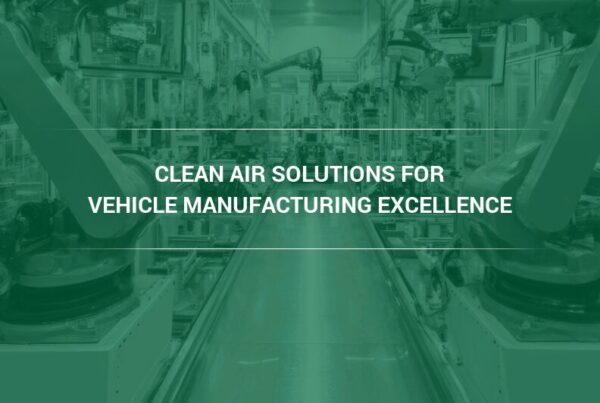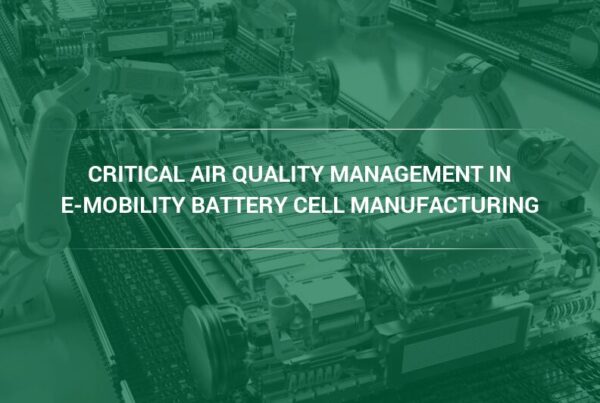In towns and cities around the world, air pollution from car exhaust, coal-burning stoves, power generation facilities, factories, and farms, continues to affect the quality of life for people living and working in or around these areas, forcing them to use air filters for protection.
Study after study proves that air pollution poses a real and serious risk to public health, so much so that it is linked to around 6.5 million premature deaths around the world, accounting for two-thirds of all fatalities caused by environmental pollution.
This includes air pollution from outdoor sources like toxic gases and airborne particulate matter (PM) and indoor sources such as the burning of solid fuels like wood and charcoal.
“Combustion is perhaps the single biggest contributor to air pollution,” explains Camfil USA’s Charlie Seyffer, Manager of Marketing & Technical Materials for commercial air filters and 37-year ASHRAE member and active committee participant. “The burning of solid and liquid fuels generates toxic hydrocarbons, volatile organic compounds, particles, and impurities like sulfur oxides and metals.”
Not surprisingly, the problem of air pollution is especially prominent in the world’s major cities, where industrialization and a high volume of vehicle traffic combine to create smog, soot and other airborne pollutants that threaten the health and safety of the public.
However, the good news is that some of the mayors of these cities are taking action, and for a good reason. With major cities being at the forefront in the fight against air pollution and climate change, mayors and city councils have firsthand knowledge of the crisis and the need for environmental protection.
Mayors Believe There is Still Time to Solve Outdoor and Indoor Air Quality Crisis
Although the challenges posed by high levels of air pollution on outdoor and indoor air quality are immense, some city mayors believe it’s not too late to solve the problem.
As New York Mayor Bill de Blasio told the Huffington Post, “We know we have a lot more to do. It’s going to take a lot of resources. It’s going to take public education. It’s going to take community organizing. But this is the way of the future if we’re going to save our Earth.”
The growing body of literature on the damaging effects of living with dirty air has compelled city leaders like Mayor de Blasio to launch initiatives and push for legislation to bring down pollution emissions.
In 2015, Mayor de Blasio signed into law the most comprehensive update to New York City’s Air Pollution Control Code in the last four decades. The law effectively erased obsolete and ineffective provisions in the Code, and introduced new emissions standards on pollution sources with little or no regulation, despite being major contributors to poor air quality.
These sources include:
- Fireplaces
- Commercial charbroilers
- Food trucks
- Refrigeration trucks
London Experimenting with HEPA Filtration Systems
In London, on the other hand, the city government is accepting innovative HEPA filtration systems and passing laws penalizing air pollution emissions.
In October 2017, London Mayor Sadiq Khan launched a £10 toxicity ‘T-Charge’ or emissions surcharge, targeting older, more polluting cars plying the city’s roads. The levy, which aims to improve air quality in the capital, mainly applies to diesel cars and trucks registered before 2006, but it also includes newer car models known to generate high levels of air pollution.
The T-Charge will apply on top of and alongside during similar operating times as the Congestion Charge, another levy aimed at drivers who enter low-emissions zones from Monday to Friday, 7:00 a.m. to 6:00 p.m. All in all, it will cost drivers around £21.50, roughly $24.00, to enter “clean” zones.
Taking its cue from the city, local tech firms are also thinking of new ways to use existing air filter technology to capture and remove airborne pollutants.
One such company is London-based Airlabs, which teamed up with the Body Shop in 2017 to build “breathing bus stops” in strategic locations in the city. These anti-pollution bus stops are outfitted with air filtration systems that trap airborne pollutants in the immediate area, creating a bubble of clean air for people waiting for the bus.
The Netherlands Turning to Air Purifiers and a Total Ban on Cars Powered by Fossil Fuels
The Dutch, on the other hand, have taken a more drastic approach, and are taking the technology found in air purifiers to build a smog-eating air filtration tower.
In September 2015, Dutch designer Daan Roosegaarde unveiled the “Smog Free Tower” in Rotterdam after a successful fundraising campaign on Kickstarter. Designed to improve the city’s air quality, the seven-meter tall structure captures airborne pollutants to create a pocket of clean air in its vicinity. Roosegarde’s vision of installing the tower in a park came to fruition, providing people with a respite from contaminated air.
The machine is reportedly capable of processing 30,000 cubic meters of air in an hour—enough to capture smog particles and breathe out clean air using around the same amount of electricity as a standard water boiler.
Local politicians also want to pass a complete ban on the sale of all cars powered by fossil fuels by 2025, pushing electric- and hydrogen-powered vehicles as alternatives. The proposed law, however, would allow owners of gasoline or diesel cars to keep them.
Why High Efficiency Air Filtration Systems Are More Important than Ever
For people with respiratory problems, the need for high efficiency air filtration systems has never been more important. Research on air pollution has repeatedly warned us that breathing in air pollutants can increase the risk of:
- Respiratory diseases like asthma, chronic obstructive pulmonary disorder (COPD), and lung cancer
- Heart disease
- Stroke
- Low immune function
- Even obesity
According to the World Health Organization, tens of thousands of premature deaths happen each year in the United States alone due to air pollution.
“Air quality is especially important to the most vulnerable segments of the population like expecting mothers,” said Seyffer. “These also include children, the sick, and the elderly.”
If the problem is serious enough to force mayors in wealthy cities like London and New York to take action, one can only imagine how devastating it is in developing countries, where access to health care is limited and governments barely have enough resources to feed their citizens, much less procure systems to purify the air.
If anything, this proves that air pollution is a universal problem that affects everyone, regardless of status, nationality, or gender.
How to Choose an Air Purification Systems
In cities with high levels of air pollution, it’s no longer enough for the location population to seek refuge indoors. What appears to be a well-sealed home or building can still have gaps between doors and windows, not to mention cracks on walls and floors, where polluted air can enter. Our air purification systems are designed to provide the best solution for keeping indoor air quality at safe levels in your building or facility.
When choosing an air filter system, it’s important to work with a reliable maker of industrial and commercial air filtration systems. Air filtration experts at our Camfil USA locations will happily take the time to understand the layout of your building, your particular contaminant exposure, or your immediate containment needs.
At Camfil USA, we take our responsibility of protecting buildings and facilities from air pollution seriously. Talk to our team to learn more about how to protect your buildings indoor air quality against air pollution. You may also explore our catalog to learn more about our air filtration products.
Lynne Laake
Camfil USA Air Filters
T: 888.599.6620
E: Lynne.Laake@camfil.com
F: Friend Camfil USA on Facebook
T: Follow Camfil USA on Twitter



